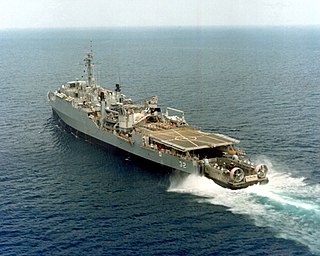
Wreck diving is recreational diving where the wreckage of ships, aircraft and other artificial structures are explored. Although most wreck dive sites are at shipwrecks, there is an increasing trend to scuttle retired ships to create artificial reef sites. Diving to crashed aircraft can also be considered wreck diving. The recreation of wreck diving makes no distinction as to how the vessel ended up on the bottom.

An artificial reef is a human-created underwater structure, typically built to promote marine life in areas with a generally featureless bottom, to control erosion, block ship passage, block the use of trawling nets, or improve surfing.

HMCS Yukon was a Mackenzie-class destroyer that served in the Royal Canadian Navy (RCN) and later the Canadian Forces. She was the first Canadian naval unit to carry the name. She was named for the Yukon River that runs from British Columbia through Yukon and into Alaska in the United States.

USS Spiegel Grove (LSD-32) was a Thomaston-class dock landing ship of the United States Navy. She was named for Spiegel Grove, the home and estate in Fremont, Ohio of Rutherford B. Hayes, the 19th President of the United States.
The Artificial Reef Society of British Columbia (ARSBC) is a registered non-profit society based in Vancouver, British Columbia (BC), and is a registered tax-deductible charity in Canada.
MV Adolphus Busch was a cargo ship that was sunk off of Looe Key, Florida, as an artificial reef and dive site.

The San Diego-La Jolla Underwater Park spans 6,000 acres (24 km2) of ocean bottom and tidelands. The park's four distinct habitats make it a popular destination for snorkelers and scuba divers. The park was created by the City of San Diego in 1970 and actually has two other parks within it: the "look but don't touch" Ecological Reserve and the Marine Life Refuge.

USNS General Hoyt S. Vandenberg (T-AGM-10) was a General G. O. Squier-class transport ship in the United States Navy in World War II named in honor of U.S. Army Chief of Engineers Harry Taylor. She served for a time as army transport USAT General Harry Taylor, and was reacquired by the navy in 1950 as USNS General Harry Taylor (T-AP-145).
USS YO-257 was a Yard Oiler of the United States Navy that was scuttled two miles off Waikiki, Honolulu, Hawaii in 1989.
MS King Cruiser was a car ferry that sank off the West Coast of Southern Thailand on 4 May 1997.

Sinking ships for wreck diving sites is the practice of scuttling old ships to produce artificial reefs suitable for wreck diving, to benefit from commercial revenues from recreational diving of the shipwreck, or to produce a diver training site.

The Hilma Hooker is a shipwreck in Bonaire in the Caribbean Netherlands. It is a popular wreck diving site.
Shark River Reef is an artificial reef located in the Atlantic Ocean, 15.6 miles southeast of Manasquan Inlet, off of the coast of Ocean County, New Jersey. The site contains almost 4 million cubic yards of dredge rock material. Although 96% of the total reef material is rock, the site also contains numerous subway cars.
Swami’s State Marine Conservation Area (SMCA) is a marine protected area that extends offshore of Encinitas in San Diego County on California’s south coast. The SMCA covers 12.65 square miles. The SMCA protects marine life by limiting the removal of marine wildlife from within its borders.

Recreational dive sites are specific places that recreational scuba divers go to enjoy the underwater environment or for training purposes. They include technical diving sites beyond the range generally accepted for recreational diving. In this context all diving done for recreational purposes is included. Professional diving tends to be done where the job is, and with the exception of diver training and leading groups of recreational divers, does not generally occur at specific sites chosen for their easy access, pleasant conditions or interesting features.

The Florida Public Archaeology Network, or FPAN, is a state supported organization of regional centers dedicated to public outreach and assisting Florida municipalities and the Florida Division of Historical Resources "to promote the stewardship and protection of Florida's archaeological resources." FPAN was established in 2004, upon legislation that sought to establish a "Florida network of public archaeology centers to help stem the rapid deterioration of this state's buried past and to expand public interest in archaeology."
The following index is provided as an overview of and topical guide to Wikipedia's articles on recreational dive sites. The level of coverage may vary:

Recreational dive sites are specific places that recreational scuba divers go to enjoy the underwater environment or for training purposes. They include technical diving sites beyond the range generally accepted for recreational diving. In this context all diving done for recreational purposes is included. Professional diving tends to be done where the job is, and with the exception of diver training and leading groups of recreational divers, does not generally occur at specific sites chosen for their easy access, pleasant conditions or interesting features.
MV Liberty was a Russian cargo ship which was turned into an artificial reef south of Cyprus in 2009. The ship had a gross tonnage of 225 GT, a length of 37 metres (121 ft), and a beam of 7 metres (23 ft).














